Concrete coating systems
by Sally Bouorm | December 1, 2011 10:46 am
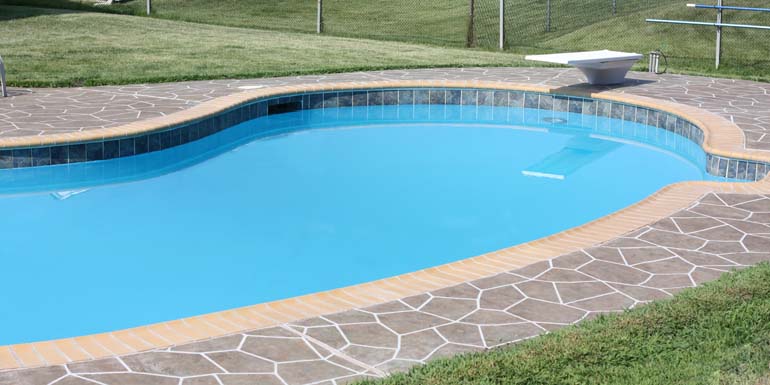 [1]
[1]By Elena Danke
Today’s concrete pool decks no longer need to be plain grey. There are many options on the market that allow pool designers/builders to beautify a concrete pool deck. Aside from esthetics, should builders go to the trouble of designing an elaborate concrete deck, they should also understand the advantages of protecting it with a deck coating system.
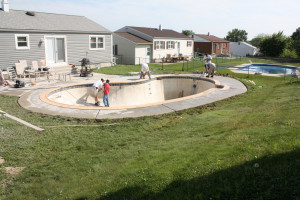 [2]When designing a new swimming pool project, deciding what materials will be used to construct the pool deck can sometimes be difficult to determine. Where one building material may seem like a more sensible solution over another, keep in mind there are some important factors to consider—especially when dealing with concrete pool decks.
[2]When designing a new swimming pool project, deciding what materials will be used to construct the pool deck can sometimes be difficult to determine. Where one building material may seem like a more sensible solution over another, keep in mind there are some important factors to consider—especially when dealing with concrete pool decks.
The case for deck coating systems
Concrete, whether stamped, stained or pigmented is not waterproof. Exposure to the elements (e.g. rain and snow), or simple spills and splashes from the pool are all factors that can significantly increase the likelihood of cracking, heaving, spalling (chipping/flaking) and discolouration.
For instance, when rain falls onto the pool deck, it penetrates the concrete and any joints in the deck. Water accumulation can have multiple effects on a non-coated concrete pool deck and the surrounding area. If a significant amount of rain should fall, it can cause the soil beneath the deck to wash out, which causes heaving and movement in the concrete. As a result, cracks can form, which are not only esthetically displeasing, but also create even larger areas for future water penetration.
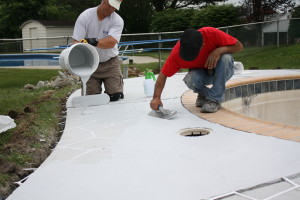 [3]
[3]Non-coated concrete decks are also less resistant to the chemicals used in balancing pool water—especially when concentration levels are higher due to improper care/dosing. By using a coating system, the pool deck is more resistant, and therefore less likely to become damaged from splash out and/or overexposure to pool water.
Thermal movement caused by temperature swings can also cause concrete pool decks to shift and swell. Thermal shock occurs when surface temperatures are hot and it rains, as rain water is colder than the deck, it literally shocks the concrete, which leads to possible cracking.
To combat this, coatings or micro-toppings are available with increased flexibility, which can help bridge and hide some of the cracks. Not only is it more appealing to the eye, it also helps to maintain the integrity of the waterproof seal.
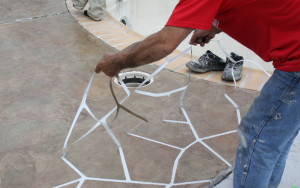 [4]
[4]Another factor to consider with respect to concrete pool decks is the water that permeates into the soil can also travel through the concrete pool shell, causing pool coatings to delaminate. This is another reason why it is always recommended that the surrounding deck be waterproofed in addition to the swimming pool.
Finally, leaching vapour drive (i.e. water vapour constantly diffuses through building materials from the warm, humid side of a structure toward the cold, dry side) from the soil can cause discolouration on uncoated concrete decks. While a ‘weathered’ look is sometimes desired, this is not the effect that would result. A weathered look can be easily created by staining a concrete coating system prior to application. This not only creates a beautiful looking deck but also protects it from the elements. It would be a shame to waste money on a beautiful stamped concrete deck, only to have it littered with cracks a few months after finishing it.
Flexible versus rigid coatings
Once the decision to use a deck coating system is made, there are additional factors to consider. The next decision, which will probably have the biggest impact on the end result, is whether a flexible or rigid coating system should be used.
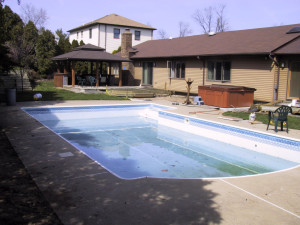 [5]
[5]The major difference between the two types of coatings is cost. Rigid coatings are generally less expensive because they do not have as many polymers and additives in the product and are easier to clean. Flexible coatings, on the other hand, are able to ‘move’ with the substrate, providing some significant advantages.
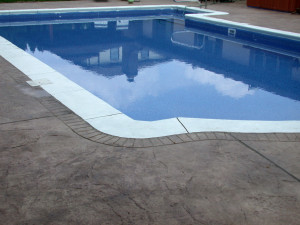 [6]
[6]For example, the ability to bridge cracks, as mentioned earlier, is a huge advantage in terms of cosmetics, performance and protection. Flexible coatings also tend to have superior bonding characteristics over the rigid variety, which allows them to conform as the pool deck shifts and moves. Rigid coatings can potentially move in different ways, whereby causing delamination issues. Increased polymer content in flexible coatings also provides increased adhesion properties.
Certain flexible coatings with elongation rates of 50 per cent or greater can also be applied to wood substrates (i.e. decks). This is a unique advantage because it allows contractors to take an ordinary wooden deck and give it a completely different look and appeal for a fraction of the cost of tearing it out, pouring new concrete and either stamping or staining it.
Increase safety around the pool
By using different aggregates in deck coating systems it is possible to create surfaces with increased slip-resistant characteristics than plain concrete. This is an important consideration when selecting a deck coating system to help eliminate or reduce potential slip and fall accidents—especially on wet surfaces—which account for billions of dollars in injuries and insurance claims each year.
Slip resistance is measured by the American Society for Testing and Materials (ASTM) Standard C1028–Standard Test Method for Determining the Static Coefficient of Friction of Ceramic Tile and Other Like Surfaces by the Horizontal Dynamometer Pull-Meter Method and the Americans with Disabilities Act (ADA) guidelines, which recommend a coefficient of friction (COF) of 0.6 or higher in dry and wet conditions, and 0.8 on ramped surfaces, to provide safe surfaces for all people to traverse across. Slip-resistant characteristics are graded using a COF scalar value, which describes the ratio of force of friction between two bodies and the force pressing them together. These guidelines and local requirements should be evaluated when selecting a pool deck coating, especially since slips are more likely to occur where splashing and puddles are common.
There are various coating systems available today, which approach the solution in different ways.
Aggregates
Some deck coating systems (generally epoxy and urethane based) allow different sized aggregates to be broadcast into the coating’s surface, while it is still wet, to vary the degree of slip resistance. Other products, such as cement-based coatings, already have a mix of aggregates in the product. This allows applicators to select a coating system with varying degrees of slip resistance, such as ‘heavy duty,’ ‘regular,’ ‘fine,’ or ‘ultra fine’ to achieve the desired surface.
Both methods work, it is simply a matter of budget and preference of application, as broadcasting an aggregate is an additional step that requires more labour hours.
Rubber fillers
Other products on the market use innovative rubber fillers, which can provide a very soft surface. This is a great advantage when designing areas where children are prone to ‘horsing around’ and potentially falling. However, this coating system is not waterproof. If the project requires waterproofing, an additional coating system must be applied first.
Similar to cementitious coatings these systems can be used on pool decks, pool interiors and on splash pads. It should be noted, however, due to the nature of these products, they provide a porous surface and it is important to check with local health department regulations to ensure porous systems are approved for use in that specific region.
One advantage to a porous surface is its ability to eliminate standing water, as water runs through the system. This prevents mould, mildew and moisture buildup, in addition to a significantly cooler surface in comparison to other deck coating products.
Protecting the investment
While decorative concrete certainly has its benefits and applications, concrete pool decks are better protected and will last longer if a coating system is used. Thus, a deck coating system should be considered on every project to enhance the look of the pool deck, while also increasing its longevity and client satisfaction with the project.
| CONCRETE DECK COATING BENEFITS |
|---|
| Deck coating systems provide protection and extend the service life of a concrete pool deck. The following are some additional benefits:Waterproofing There is a variety of deck coating systems available; therefore, pool builders should be aware of the difference between ‘water-resistant’ and ‘waterproof’ coatings. Coatings that are 100 per cent waterproof will provide much greater protection against water penetration. This will significantly increase the life of the pool deck by decreasing cracking, spalling and other related problems. Easy to clean Less expensive |
 Elena Danke is the director of marketing for Aquafin Inc., an Elkton, Md-based manufacturer of products for waterproofing, vapour proofing and concrete repair. She is responsible for all of the company’s marketing activities including trade shows, seminars and other events. Danke holds a degree in marketing from the R.H. Smith School of Business, University of Maryland and is also active in various professional organizations such as the International Concrete Repair Institute (ICRI) and Construction Specifications Institute (CSI). She can be reached via e-mail at edanke@aquafin.net[7].
Elena Danke is the director of marketing for Aquafin Inc., an Elkton, Md-based manufacturer of products for waterproofing, vapour proofing and concrete repair. She is responsible for all of the company’s marketing activities including trade shows, seminars and other events. Danke holds a degree in marketing from the R.H. Smith School of Business, University of Maryland and is also active in various professional organizations such as the International Concrete Repair Institute (ICRI) and Construction Specifications Institute (CSI). She can be reached via e-mail at edanke@aquafin.net[7].
- [Image]: http://poolspamarketing.com/wp-content/uploads/2011/12/res-pool-02.jpg
- [Image]: http://www.poolspas.ca/wp-content/uploads/2015/06/res-pool-01.jpg
- [Image]: http://www.poolspas.ca/wp-content/uploads/2015/06/troweling.jpg
- [Image]: http://www.poolspas.ca/wp-content/uploads/2015/06/pulling-stencil.jpg
- [Image]: http://www.poolspas.ca/wp-content/uploads/2015/06/Pool-deck-Before.jpg
- [Image]: http://www.poolspas.ca/wp-content/uploads/2015/06/Pool-deck-After.jpg
- edanke@aquafin.net: mailto:edanke@aquafin.net
Source URL: https://www.poolspamarketing.com/trade/concrete-coating-systems/